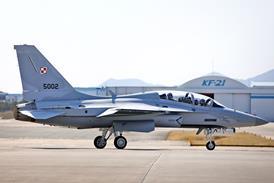DuPont Aerospace has completed two brief tethered hover tests of a subscale prototype of its controversial DP-2 vectored-thrust vertical/short take-off and landing aircraft. The 53%-scale DP-1C completed two 45s "flights" on a test stand at El Cajon, California on 30 September.
Development of the DP-2 has been under way for more than 20 years, funded almost exclusively by money added to the US defence budget by California congressman Duncan Hunter. Congress cut off funding after the project was lambasted at a special hearing in June.
DuPont has received more the $63 million in government funding since 1988, according to Congress, and Hunter had proposed earmarking an additional $6 million in the fiscal year 2008 defence budget.
The company's existing funding runs out at the end of 2007.
In the DP-2 concept, the thrust of two engines mounted side-by-side in the nose and exhausting on the centre of gravity is vectored to provide a V/STOL capability. But Congress says repeated reviews have concluded the design is not viable and is unsafe.
Congressional documents show DuPont has been warned previously that its test programme is not in compliance with US Department of Defense safety regulations.
A US Navy review in 1986 concluded the proposed DP-2, powered by two General Electric CF34 turbofans, would have insufficient thrust for VTOL capability.
A 1990 assessment by the US Defense Advanced Research Projects Agency concluded the aircraft was impractical and unsafe, the documents show.
Funding for the DP-2 was shifted to the Office of Naval Research in 1997 after DARPA refused to spend funds earmarked by Congress, the hearing was told.
Source: Flight International




















